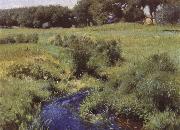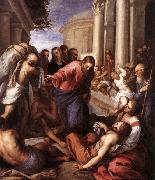
|
Dennis Miller Bunker
|
|||
|
|
|||
| 1861-1890 Dennis Miller Bunker Gallery The paintings of Bunker's early maturity in New York (ca. 1880-82) were often marine subjects, featuring a series of beached boats, painted on Long Island. In these he followed the standard academic practice of first painting loose, preparatory sketches (Beached, ca. 1881-2) prior to more conventionally finished exhibition pieces. The early portraits (Portrait of Walter Griffin, 1881, Portland Museum of Art) also evidence rigorous craftsmanship. While studying in Paris, Bunker's summer excursions to the countryside resulted in another series, this time of scenes of Larmor, a town in Brittany. The focus of these compositions, be it church spire (Brittany Town Morning, Larmor, 1884, Terra Foundation for American Art), cemetery cross, or a lone tree (Tree, 1884-5, private collection), was invariably that of a richly painted, dark graphic shape against a bright sky. Nevertheless, the pictures are characterized by soft atmospheric effects and tonal subtlety. No less subtle are the landscapes Bunker painted after returning to America; paintings done in South Woodstock, Connecticut (Pines Beyond the Fence, 1886, private collection) still favor dramatic value contrasts, with subjects carefully painted against a light sky, but the palette has grown lighter, the color more saturated. By 1887 Bunker completed his Portrait of Anne Page, a painting requiring much labor, but one of his most poignant works. In its restrained use of color, delicate modeling of form, and aesthetic elegance it is reminiscent of the works of Thayer and James McNeill Whistler. There soon followed the Boston commissions, portraits mostly of male sitters--still somber in tone, they are painted in a more confident manner, suggesting the influence of Sargent (Portrait of George Augustus Gardner, 1888, Museum of Fine Arts, Boston). Portrait Sketch of Eleanor Hardy Bunker, 1890. Private collection.That Bunker spent the summer of 1888 painting with Sargent is verified by personal correspondence, as well as through several pieces by the latter artist (Dennis Miller Bunker Painting at Calcot, 1888, Terra Foundation for American Art), but no paintings of the English sojourn by Bunker have survived; possibly he destroyed them in dissatisfaction. However, once back in Boston the experience came to fruition, for over the next two years Bunker produced a series of canvases which evidenced that he was one of the first American artists to fully understand and successfully practice impressionism. In the Greenhouse, ca. 1888, Chrysanthemums, 1888 (Isabella Stewart Gardner Museum), The Pool, Medfield, 1889 (Museum of Fine Arts, Boston), and Meadow Lands, 1890 (Museum of Fine Arts, Boston) all feature a rich palette, vertiginous compositions, and his unique "fish hook" shaped brush strokes. At the same time, Bunker's last figure pieces remained faithful to his academic training. Jessica, 1890 (Museum of Fine Arts, Boston), The Mirror, 1890 (Terra Foundation for American Art), and Eleanor Hardy Bunker, 1890 (Metropolitan Museum of Art) are characterized by a restricted color range and heightened elegance. | |||
|
|
|||
|
The Pool new19/Dennis Miller Bunker-583989.jpg Painting ID:: 54482 |
mk235 1889 Oil on canvas 45.7x61cm | ||
|
|
|||
|
PALMA GIOVANE
|
|||
|
|
|||
| Italian Mannerist Painter, ca.1548-1628 Son of Antonio Palma. A greater artist than his father, his vast oeuvre represents the impact of central Italian Mannerism but principally of Jacopo Tintoretto on Venetian painting in the generation after Titian, Tintoretto and Paolo Veronese. He died in his late seventies and was occasionally referred to as 'il vecchio', but since the 17th century he has been known as 'il giovane' to distinguish him from his great uncle. He was virtually self-taught, apart from a presumed acquaintance with his father's workshop. In 1567 he came to the attention of Guidobaldo II della Rovere, Duke of Urbino, who was to support him for four years. A possible knowledge of Federico Barocci's art at the court of Urbino left little trace on his surviving early works. The Duke sent him to Rome for study, where he spent a few months apprenticed to an unknown artist. There his sympathy was with Taddeo Zuccaro and Federico Zuccaro, who influenced the graphic style of the drawing of Matteo da Lecce (1568; New York, Pierpont Morgan Lib.), his first dated work. His Roman sojourn, which lasted until c. 1573-4, made a direct impact on some of his Venetian works and indirectly made him receptive to Tintoretto's style. A tendency in Rome in the 1560s to retreat from the most artificial and decorative aspects of Mannerism in favour of naturalism was also to affect Palma's attitude to style in his mature works | |||
|
|
|||
|
The Pool new21/PALMA GIOVANE-954467.jpg Painting ID:: 63830 |
1592 Oil on canvas Collezione Molinari Pradelli, Castenaso St John's version (John 5:1-15) of the miracle of the healing of the paralytic lays the scene in Jerusalem at the pool of Bethesda. (According to Matthew, Mark and Luke it took place at Kapernaum.) The place was a resort of the sick since the waters were believed to have miraculous curative powers. It was said that from time to time an angel, traditionally the archangel Gabriel, came and disturbed the water and that the first person to enter it afterwards was healed. But the paralytic had never succeeded in being first. Christ came there and found him. He was ordered to take up his bed and walk and immediately found himself cured. John described it as 'a place with five colonnades', and therefore represented with some such architectural feature. Christ addressing the paralytic who lies at the edge of the pool. Others, sick and infirm crowd the scene. Palma's painting was clearly inspired by the great examples of sixteenth-century Venetian art and in particular by the works of Tintoretto. The composition is typical of Palma the Younger's mature style. Compositional flair, the employment of diagonal perspectives and rich colours almost obliterated by heavy shadow as well as the theatrical eloquence of the gestures and use of foreshortening are all typical characteristics of Palma the Younger's style of painting. When he managed to control all of them, as in this splendid example, he took post-Renaissance Venetian painting, generally considered a dismal period in art, to its highest degree of effectiveness and expression. When, on the other hand, the effects he used degenerated into repetitive formulas, seventeenth-century Venetian art very quickly became monotonous. This painting is a part of the Collezione Molinari Pradelli, the most extensive private collection of seventeenth- and eighteenth-century art in Italy.Artist:PALMA GIOVANE Title: The Pool Painted in 1551-1600 , Italian - - painting : religious | ||
|
|
|||
|
Also Buy::. For Following Paintings / Artists / Products, Please Use Our Search Online: |









